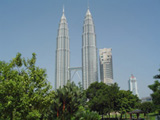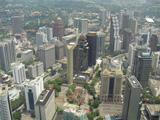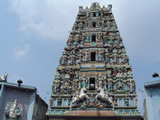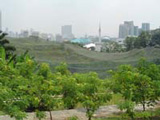 |
MALAYSIA
The Federation of Malaysia is made up of the Malacca peninsula and of the states Sarawak and Sabah, that are situated in the northern part of Borneo. The territory of Malaysia covers overall 342.000 square kilometres: it is like Italy and Switzerland together. Malaysia, mostly mountainous, is famous for its fabulous jungle, which spreads out for 500 kilometres, and is populated by a big variety of plants and animals; but it is also known for its beautiful valleys and hills that sometimes seem to appear out from nowhere, and particularly for its splendid islands and beaches of the oriental coasts. On the contrary, the northern Borneo is famous for its wild nature of tropical forest, its incontaminated beaches and islands, its moorland where also grow different carnivorous plants and for its natural parks. In this exclusive natural picture, the flora and fauna present real uncommon numbers. The jungle has a 130 million-year history - this is the oldest in the world - and shelters 145.000 kinds of plants. The forests are populated by bamboo, ebony, teak and sandal trees, and by over 200 types of palms! Here it is possible to find the Rafflesia Arnoldi, the biggest flower in the world which can reach even 1,5 m. of diameter. Likewise, unique is its fauna. In this country live more than 200 species of mammals, among which the huge asian elephants, the rhinoceros, the labiate bears, different cats (tigers, panthers, leopards), the bearded pigs, gibbons and macaques. Many deers and predatory birds are also found: from the hawk-eagle to the kite. The Borneo is also homeland of particular monkeys like those with the trunk and different orang-outan. On the beaches, moreover, cyclically land the giant turtles to lay eggs. After it has been for centuries a portuguese, dutch and english colony, Malaysia reached its independence in 1957. It is populated by 20 millions inhabitants, mostly concentrated in the peninsula of Malacca, and its population is made up of different ethnic groups: malay (54%), chinese (27%), indians (10%), and natives (9%). Islam, the official and most followed religion, lives together with the faiths of other religions: Buddhism, Taoism, Hinduism and Catholicism. The architectural landscapes are characterized by the coexistence of different styles: the mosques, the hindu and buddhist temples, the chinese districts and the various houses with the colonial style often fitted among very modern villas and skyscrapers.
Kuala Lumpur
It
is the young and beautiful capital (in spite of the name which means "muddy
watersmeet") of Malaysia. As a matter of fact, when in 1857 it started to
develop in the confluence of the two rivers Gombok and Klang, as village managed
by the chinese, and village dedicated to the hunt of tin, the zone was a muddy
place. Nowadays, nevertheless, with its million and half of inhabitants, it appears
as a clean town, provided with parks that soften the presence of various and modern
skyscrapers. The historical centre of the town presents interesting witnesses
of its colonial past. It is worth to visit: the National Mosque which
embodies contemporary designs, with traditional Islamic art, calligraphy and ornamentation.
The main dome, in the shape of an 18-pointed star, represents the 13 states of
Malaysia and their unification by the Five Pillars of Islam. The Jamek Mosque,
situated at the confluence of the two rivers Klang and Gombak, with its wonderful
inner gardens. This grand old mosque was designed by British architect Hubbock
in 1909, it incorporates many features of moorish architecture. The KL Railway
Station, built in 1910, the islamic influences in the design of graceful
arches and minarets make this one of the most distinctive railway station in the
world. The building underwent extensive renovations and refurbishment in 1986.
This was the nerve centre of the malaysian railways that stretches from the north
to the south of the country, and eastward to Kelantan before its recent relocation
to KL Sentral. A few steps far away we find the Sri Maha Miriamman Temple.
Built in 1873 it is one of the oldest and most decorated Hindu temples in the
country. The intricately adorned portico deities, decorated with gold and precious
stones, depicts stories from Hindu mythology. This is the starting point of the
annual Thaipusam festival procession, when the traditional chariot or "ratham"
followed by thousands of people begin a 7 to 8-hour walk to Batu Caves. Merdeka
Square, on the turf of which, a marble plaque marks the spot when the
Union Jack was lowered at midnight on August 30, 1957, and the Malaysian flag
hoisted for the first time - marking the birth of a nation. The flagpole is the
tallest in the world. The Royal Selangor Club, in elegant tudor
style and St. Mary's Cathedral are but two famous landmarks that
can be found nearby. The Sultan Abdul Samad Building, built in 1848
by British architects, Norman and Hubback, is an historical landmark famed for
its Islamic-inspired architecture. Today, it houses the Courts of Law. The 40-metre
high clock tower is a popular gathering point for the New Year and National Day
celebrations, parades and revellers. It is also interesting to visit the
National Art Museum, which shelters contemporary art masterpieces,
and the Central Market, which was once the city's largest fresh
produce market. Today, it functions as a popular tourist attraction for arts and
crafts, restaurants and cultural performances, similar to London's famed Covent
Garden or the Fisherman's Wharf in San Francisco. Another interesting place from
where it is possible to enjoy the view of KL is Menara Tower, the
tallest tower in Southeast Asia and currently the fourth tallest structure in
the world which stands at an amazing 421 meters at the pinnacle of Bukit Nanas.
The tower-head houses a revolving restaurant and an observation platform that
gives a bird's-eye view of Kuala Lumpur. The Bukit Nanas Nature Park nearby is
also worth a visit. The pride of the nation, the Petronas Twin Towers,
are the world tallest free-standing towers. Standing at a dizzying height of 451,9
metres, the towers were designed by renowned architect Cesar Pelli, and sit amidst
a 50-hectare landscaped park. The sky bridge that joins the two towers at the
41st floor is open to the public between 10 a.m. and 12.45 p.m. and 3 p.m. and
4.45 p.m. daily, except on Mondays. Tickets are available on a first-come-first-serve
basis from the ticket counter, which opens from 8.30 a.m. to 5 p.m A total of
1.280 tickets are issued daily, free-of-charge. A walk to the Lake Gardens,
the most famous public gardens of the town, is also worth. The town boasts wonderful
gardens dedicated to the orchids (3.000 species), to the hibiscus (2.200 varieties),
to the butterflies (120 species) to the birds (100 species) and to the deers.
Right in the Lake Gardens is located KL Bird Park, a must-see attraction
that is just 10-minute drive from the city centre. Visitors can enjoy the colourful
spectacle of birds flitting about freely, listen to melodic songs, and just relax
in natural, beautifully landscaped surroundings. Stroll through the Walk-In Free
Flight Aviary - the largest in the world and home of more than 3.000 birds comprising
about 200 local and foreign species. Little far away it is also worth to visit
the National Monument, designed by American artist, Felix Weldon
and cast in Italy, it commemorates servicemen who sacrificed their lives during
the struggle against the communist insurgency in the 1950s. Of course we cannot
miss Chinatown and the Art-decò style buildings along Klang
river, on Jalan Ampang street. To finish, only 12 kilometres far away from KL
are located the Batu Caves that contain a hindu temple complex that
comprises three grand caves: the Dark Cave, the Museum Cave and the Temple Cave.
The Dark Cave contains brilliant rock formations, while the Museum Cave has pictures
and statues that recreate scenes from indian mythology. The energetic can climb
272 steep steps to reach Temple Cave and see the Hindu shrine where devotees gather
during the Hindu festival of Thaipusam. This world-renowned event is held annually
in January or February.







